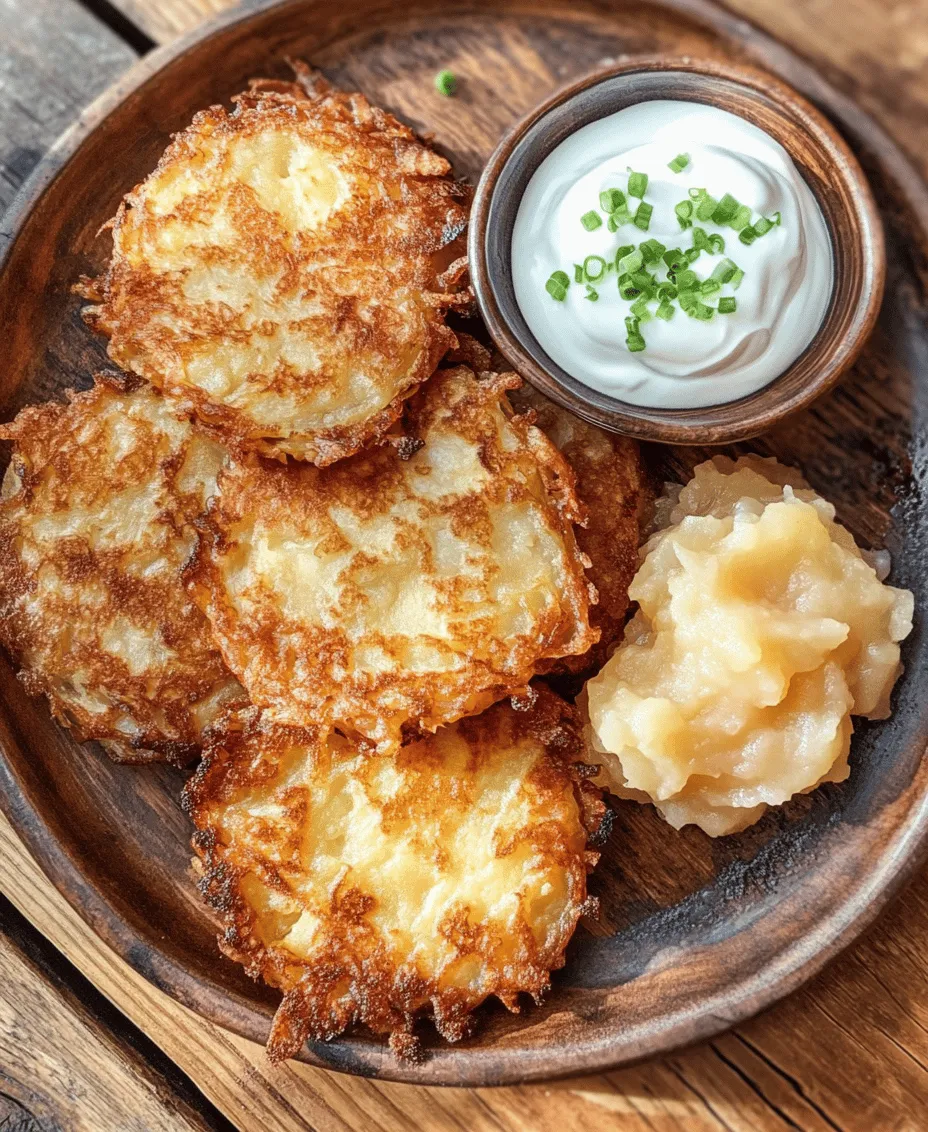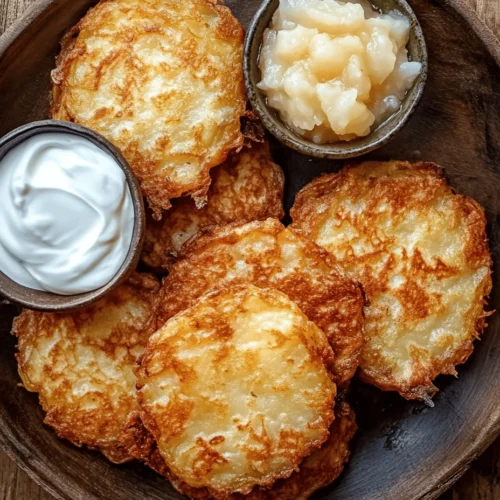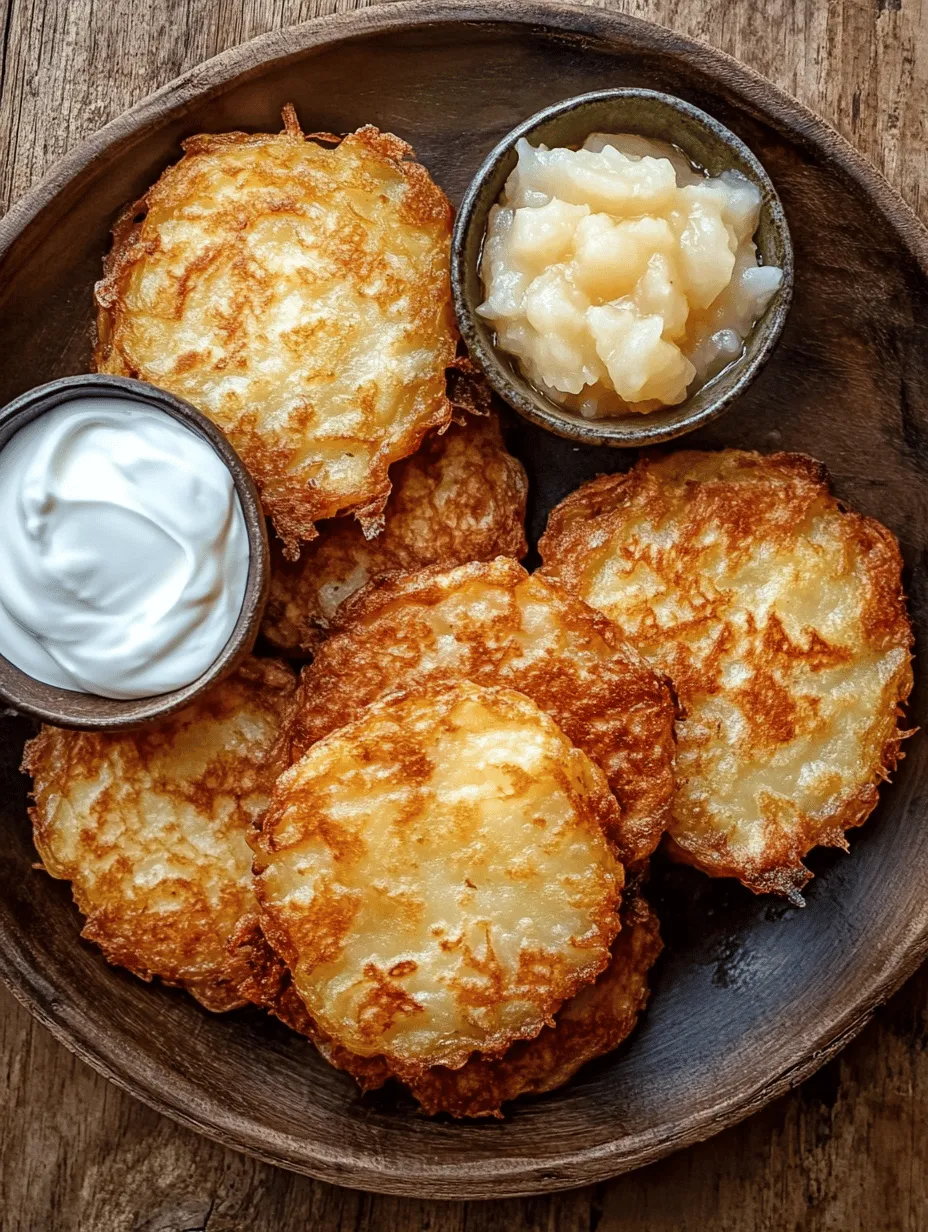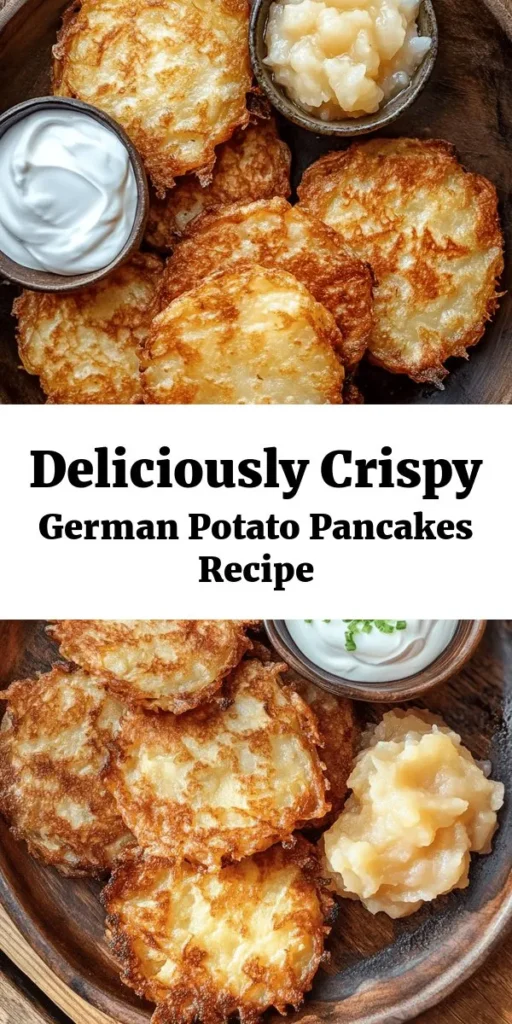Introduction
If you’ve ever been enchanted by the aroma of freshly fried potato pancakes wafting through a bustling German market, you’re not alone. Kartoffelpuffer, or German potato pancakes, are a beloved staple in German cuisine, celebrated for their crispy texture and savory flavor. These delightful treats are often enjoyed during festive occasions, family gatherings, or simply as a comforting meal at home. The joy of preparing Kartoffelpuffer lies not only in the cooking process itself but also in the satisfaction of sharing this traditional dish with loved ones.
The origins of Kartoffelpuffer can be traced back to rural Germany, where potatoes were a primary food source. Over the centuries, this dish has evolved into a cherished comfort food, often served with a variety of condiments like applesauce, which adds a sweet contrast, or sour cream for a creamy finish. Whether enjoyed as a side dish or a main course, Kartoffelpuffer holds a special place in the hearts of many, embodying the warmth and tradition of German cooking.
In this article, we will delve into the rich history of Kartoffelpuffer, explore its regional variations, and guide you through the essential steps to master this delightful recipe in your own kitchen. So gather your ingredients and get ready to experience the joy of creating crispy German Kartoffelpuffer!
Understanding Kartoffelpuffer
A Brief History and Tradition
Kartoffelpuffer has deep roots in German culinary tradition, with references to potato pancakes dating back to the 16th century. Originally a peasant dish, it was a practical way to use up leftover potatoes and other ingredients that were readily available in rural households. Over time, Kartoffelpuffer became a popular item at fairs, markets, and festive celebrations, symbolizing the heart of German comfort food.
The dish is not only a delicious treat but also a cultural artifact, representing the resourcefulness and creativity of German home cooks. It has been passed down through generations, with families often sharing their own variations and secret ingredients. The communal aspect of making Kartoffelpuffer, often involving friends and family, adds to its charm, transforming the cooking process into a joyful experience.
Regional Variations
As with many traditional recipes, Kartoffelpuffer can vary significantly across different regions of Germany. In some areas, such as Bavaria, they may be served alongside hearty meats, while in others, like the Rhineland, they are often paired with sweet toppings. The basic ingredients remain the same, but regional preferences influence the preparation and serving styles.
For instance, in some parts of Germany, Kartoffelpuffer might include grated carrots or zucchini for added flavor and nutrition, while others may incorporate herbs like chives or parsley. The method of preparation can also differ; some recipes call for a food processor to quickly grate the potatoes, while others advocate for the classic hand-grating method, which can enhance the texture and taste.
Whether you prefer a classic recipe or a regional twist, the essence of Kartoffelpuffer remains unchanged: a crispy, golden-brown pancake that is both satisfying and comforting.
The Appeal of Kartoffelpuffer
Kartoffelpuffer is more than just a dish; it is an experience that evokes nostalgia and warmth. The crispy exterior, combined with the soft, fluffy interior, creates a delightful contrast that keeps people coming back for more. This dish is particularly popular during festive seasons, such as Christmas markets, where vendors serve them hot and fresh, often accompanied by delicious toppings.
The versatility of Kartoffelpuffer adds to its appeal. While traditionally served with applesauce or sour cream, they can also be enjoyed with a variety of toppings, from savory options like smoked salmon or cheese to sweet variations with cinnamon and sugar. This adaptability makes Kartoffelpuffer a favorite for any occasion, whether it’s a cozy family dinner or a festive gathering with friends.
Essential Ingredients for Perfect Kartoffelpuffer
To create the perfect Kartoffelpuffer, selecting the right ingredients is crucial. Each component plays a vital role in achieving that signature crispy texture and rich flavor. Here’s a breakdown of the essential ingredients you’ll need:
Potatoes
The star ingredient of Kartoffelpuffer is, of course, the potatoes. When it comes to frying, starchy varieties like Russet or Yukon Gold are highly recommended. These types contain a higher starch content, which helps create a fluffy interior while allowing the exterior to crisp up beautifully. Additionally, it’s important to use fresh, firm potatoes for the best results. Avoid using waxy potatoes, as they may not yield the desired texture.
Onion
Onions add an essential layer of flavor and complexity to Kartoffelpuffer. Finely grated or chopped onions enhance the overall taste, providing a subtle sweetness that balances the savory notes of the potatoes. They also contribute to the moisture content of the mixture, ensuring that the pancakes remain tender.
Eggs
Eggs serve as a binding agent in the Kartoffelpuffer mixture, helping to hold everything together during cooking. They also contribute a rich flavor and can enhance the overall texture of the pancakes. Typically, one or two large eggs are sufficient, depending on the quantity of potatoes used.
Flour and Baking Powder
To achieve the right consistency, a small amount of flour is necessary. Flour helps absorb excess moisture and contributes to the structure of the pancakes, ensuring they hold their shape while frying. Baking powder is often included to provide a slight lift, making the Kartoffelpuffer lighter and fluffier. The combination of these two ingredients is essential for the perfect texture.
Seasonings
When it comes to seasoning, simplicity is key. A generous pinch of salt and freshly ground black pepper enhances the natural flavors of the potatoes and onions. For those who enjoy a hint of warmth, a touch of nutmeg can be added, as it complements the savory aspect of the dish beautifully.
Oil
Lastly, the choice of oil is crucial for frying Kartoffelpuffer. High smoke point oils such as vegetable oil, canola oil, or sunflower oil are ideal for achieving that perfect golden-brown crust. Maintaining the right oil temperature is critical; too low, and the pancakes will absorb excess oil, becoming greasy, and too high can lead to burnt edges before the inside is cooked through.
Step-by-Step Instructions for Making Kartoffelpuffer
Now that you’re familiar with the background and essential ingredients, it’s time to dive into the step-by-step process of making Kartoffelpuffer. Following these instructions will help you achieve the perfect balance of crispiness and flavor.
1. Prepare the Potatoes and Onions: Start by peeling the potatoes and onions. Using a box grater or a food processor, grate the potatoes and onions into a large bowl. If you prefer a chunkier texture, you can leave the potatoes slightly coarsely grated.
2. Drain Excess Moisture: Once the potatoes and onions are grated, it’s essential to remove excess moisture. Transfer the mixture to a clean kitchen towel or cheesecloth, gather the corners, and twist to squeeze out as much liquid as possible. This step is crucial for achieving that crispy texture.
3. Mix the Ingredients: In a large mixing bowl, combine the drained potato-onion mixture with the eggs, flour, baking powder, salt, pepper, and nutmeg (if using). Stir until everything is well combined. The mixture should be thick enough to hold its shape without being too dry.
4. Heat the Oil: In a large frying pan or skillet, heat about 1/4 inch of oil over medium-high heat. To test if the oil is ready, drop a small spoonful of the potato mixture into the pan; if it sizzles immediately, the oil is hot enough for frying.
5. Fry the Kartoffelpuffer: Using a spoon or a small ice cream scoop, drop tablespoons of the potato mixture into the hot oil, flattening them slightly with the back of the spoon to form pancakes. Fry in batches, being careful not to overcrowd the pan. Cook for about 3-4 minutes on each side or until golden brown and crispy.
6. Drain and Serve: Once cooked, transfer the Kartoffelpuffer to a plate lined with paper towels to absorb excess oil. Repeat the frying process with the remaining mixture. Serve hot with your choice of toppings, such as applesauce, sour cream, or even a sprinkle of fresh herbs.
By following these detailed steps, you will be well on your way to mastering the art of making crispy German Kartoffelpuffer. Enjoy the process, and don’t forget to invite friends and family to join you in savoring this delightful dish!

Preparing the Potatoes
The foundation of any great Kartoffelpuffer lies in the preparation of the potatoes. To achieve that coveted crispiness, moisture removal is crucial. When potatoes are grated, they release moisture, which can cause the pancakes to become soggy during frying. There are several effective methods to ensure your potatoes are dry before mixing the batter.
1. Grating and Draining: After grating the potatoes, transfer them to a clean kitchen towel or cheesecloth. Gather the edges of the towel and twist to squeeze out as much liquid as possible. This step not only removes excess moisture but also helps concentrate the potato flavor.
2. Using a Salad Spinner: Alternatively, you can place the grated potatoes in a salad spinner, which will help remove moisture efficiently. Spin until you notice the water has drained out, and then transfer the potatoes to a bowl.
3. Letting Them Sit: If you prefer a more hands-off approach, you can let the grated potatoes sit in a colander for about 10-15 minutes. This will allow excess moisture to drain naturally, although it may not be as effective as the previous methods.
Mixing Ingredients
Once your potatoes are ready, it’s time to mix the ingredients. For the best results, you want a well-combined batter without overmixing. Start by adding the grated potatoes to a large mixing bowl.
1. Combine Ingredients Gently: Add in the finely chopped onion, eggs, flour, salt, and pepper. Use a spatula or wooden spoon to fold the ingredients together. The goal is to coat the potato shreds evenly with the flour and combine with the eggs without breaking down the structure of the potatoes. Overmixing can lead to a gummy texture, which is not desirable for Kartoffelpuffer.
2. Adjusting Consistency: If the batter feels too loose, consider adding a little more flour until you reach a good consistency that holds together well. However, be cautious not to add too much, as this can alter the flavor and texture.
Heating the Oil
Frying the Kartoffelpuffer correctly is essential for achieving that perfect golden-brown exterior. The ideal frying temperature is around 350°F (175°C).
1. Testing Oil Readiness: To check if the oil is hot enough, drop a small amount of the batter into the pan. If it sizzles immediately and rises to the surface, the oil is ready for frying. You can also use a thermometer to monitor the temperature accurately.
2. Choosing the Right Oil: Opt for oils with high smoke points, such as vegetable oil or canola oil. These oils will not only fry the pancakes effectively but also impart a neutral flavor that allows the potato taste to shine.
Forming Pancakes
Forming the patties is a crucial step in the frying process. To ensure even cooking, follow these tips:
1. Portioning: Using a large spoon or ice cream scoop, take a portion of the batter and place it directly into the hot oil. Flatten the batter slightly with the back of the spoon to form a patty. The thickness should be about 1/2 inch to ensure that the centers cook through without burning the outsides.
2. Spacing: Leave ample space between each patty in the frying pan. This prevents them from sticking together and ensures even heat distribution.
3. Uniform Size: Aim for uniformity in size to ensure that all pancakes cook at the same rate. This will give you a consistent texture and appearance.
Frying Techniques
Frying the Kartoffelpuffer to perfection requires attention to timing and heat control.
1. Cooking Time: Fry each side for about 4-5 minutes, or until they are golden brown. Keep an eye on them to prevent burning; if they brown too quickly, reduce the heat slightly.
2. Adjusting Heat: If you notice that the oil starts to smoke or the pancakes are browning too fast, lower the heat. Conversely, if the oil isn’t bubbling around the edges of the pancakes, increase the heat.
3. Batch Frying: Fry in batches, ensuring the oil temperature recovers between batches. This helps maintain a consistent frying environment.
Draining
Once cooked, it’s important to drain the excess oil from the Kartoffelpuffer to achieve a less greasy final product.
1. Using Paper Towels: Place the fried pancakes on a plate lined with paper towels. This will absorb any excess oil, keeping them crispy.
2. Cooling Racks: For even better results, transfer the pancakes to a cooling rack. This allows air to circulate around them, preventing them from becoming soggy.
Serving Suggestions
Kartoffelpuffer can be enjoyed in various ways, making them versatile for any meal. Traditionally, they are served with applesauce and sour cream, which not only enhances their flavor but also balances the dish’s richness.
1. Classic Pairings: The sweetness of applesauce complements the savory notes of the pancakes beautifully, while sour cream adds a creamy, tangy element.
2. Customization: Feel free to experiment with other toppings. Chopped chives or green onions can add freshness, while a sprinkle of paprika or a dash of hot sauce can provide a kick of flavor.
3. Creative Options: Consider serving Kartoffelpuffer alongside smoked salmon or a dollop of caviar for a luxurious twist. They also pair well with fresh salads, making for a light and satisfying meal.
Nutritional Benefits of Kartoffelpuffer
When it comes to nutrition, Kartoffelpuffer offers several benefits, primarily due to its main ingredient: potatoes.
1. Caloric Content: A serving of Kartoffelpuffer typically contains around 200-300 calories, depending on the size and amount of oil used for frying.
2. Key Nutrients: Potatoes are a good source of vitamins C and B6, potassium, and dietary fiber. These nutrients contribute to overall health, including heart health and digestion.
3. Healthier Alternatives: If you are looking to make the dish healthier, consider options such as:
– Baking Instead of Frying: You can bake the patties at 400°F (200°C) for about 20-25 minutes, flipping halfway through for even browning.
– Using Less Oil: Reducing the amount of oil used for frying can lower the calorie count. Alternatively, use an air fryer for a crispy texture without the excess oil.
Cultural Significance and Serving Suggestions
Kartoffelpuffer holds a special place in German culture, often associated with festivals, markets, and street food.
1. Festivals and Markets: You’ll find Kartoffelpuffer served at Christmas markets and fairs, where they are enjoyed as a warm, comforting snack during the colder months.
2. Versatility: Beyond being a side dish, Kartoffelpuffer can serve as an appetizer or even a main course when paired with hearty accompaniments like sauerkraut or a side of grilled meats.
3. Customization: Don’t hesitate to get creative with toppings. Try adding sautéed mushrooms, fried eggs, or even a dollop of pesto for a unique twist.
Conclusion
Making crispy German Kartoffelpuffer is not just about following a recipe; it’s about embracing tradition and enjoying the process of cooking. Each step, from preparing the potatoes to serving the finished dish, contributes to a delightful culinary experience that connects you to German heritage.
With their crispy exterior and soft, flavorful interior, Kartoffelpuffer are a comforting treat that can be enjoyed in a myriad of ways. Whether you’re sharing them with friends and family or savoring them alone, these potato pancakes bring warmth and joy to any table. So gather your ingredients, dive into the cooking process, and relish the satisfaction of creating a delicious homemade dish that has stood the test of time.



